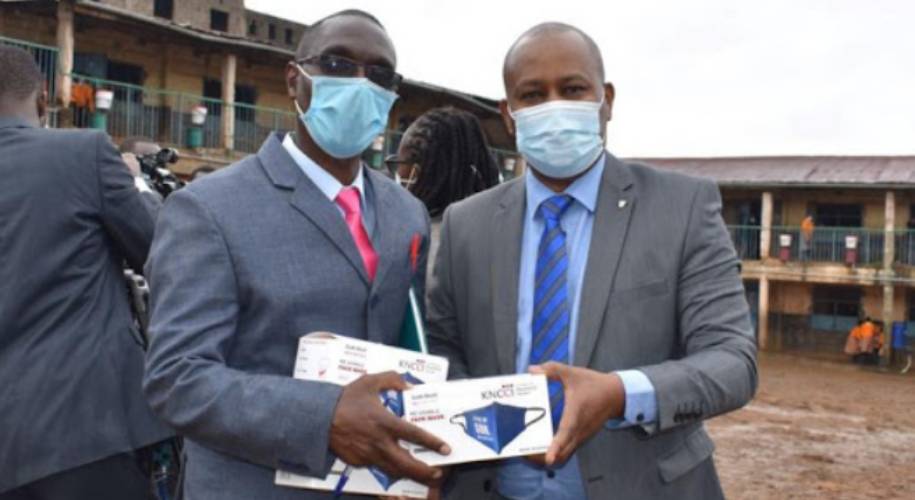
Kemsa acting CEO Mr Edward Njoroge and Mwiki Primary School Principal Mr Joseph Kamau display a pack of masks distributed to pupils. (PHOTO: Courtesy)
![]() As medical requirements in the country increase with a perennially
growing population, Kenya Medical Supplies Agency (Kemsa) is employing
high-end technology, and prioritizing partnerships to enable it
As medical requirements in the country increase with a perennially
growing population, Kenya Medical Supplies Agency (Kemsa) is employing
high-end technology, and prioritizing partnerships to enable it
Kemsa, which was established as a State corporate organisation in 2000, before being converted into an Authority in 2013 through The Kenya Medical Supplies Authority Act, has developed a customised software to smoothen operations.
Logistics Management Information Systems (LMIS) will help monitor thousands of products that Kemsa deals with. In so doing, Kemsa has reduced costs related to paperwork.
Further, the authority’s procurement department has migrated to the digital Integrated Financial Management Information System (IFMIS) to enhance control and accountability.
Kemsa Acting CEO Edward Njoroge says that with targets ahead, it is determined to make healthcare affordable and accessible soonest possible.
“Kemsa’s mandate is to procure, warehouse and distribute. We aim to deliver Kenya’s health responsibility under the Kenya Health Plan 2014-2030. We enjoy economies of scale that we seek to leverage on so that we can bring down the cost of products and technologies to lower cost of healthcare, actualizing Universal Health Care under the Big 4 agenda,” says Njoroge.
And part of the success of the authority has been found through the collaboration with county governments, and coordination with the Ministry of Health among other strategic partners.
West Pokot Governor John Lonyangapuo says that the Kemsa services have been efficient and non-discriminatory.
“Kemsa’s commodities go direct to all health facilities, whichever that facility is and wherever it is located in the country,” Prof Lonyangapuo says.
As the authority seeks to lead Kenya into achieving its Universal Healthcare goals, Kisumu governor Peter Anyang’ Nyong’o says vulnerable Kenyans are finding shelter therein.
“UHC is the solution to delivering healthcare to majority of Kenyans who do not have insurance,” says Prof Anyang’ Nyong’o, the Kisumu Governor.
Kemsa has a National distribution network with main logistics centre in Nairobi having two warehouses.
The latest of the two, which is in Embakasi, is the largest in the region and is expected to improve Kemsa’s capacity to satisfy demand for healthcare products.
“This will be the premier health care facility in East and central Africa, about 15, 000 square feet, we will centralize operations, with modern features including end-to-end supply chain visibility to serve East Africa. It is a vision 2030 product and we are very proud of it,” says Njoroge.
The Nairobi logistics centre is supported by regional distribution centres in Kisumu and Mombasa, and depots around the country. This reduces turnaround times for orders.
In 2019, Kemsa in collaboration with Coca-Cola, and with support from UNFPA, developed the Web based WMS system in Kisumu and Mombasa Distribution centers. In 2021, KEMSA in collaboration with Coca-Cola will continue to develop and enhance the WMS to improve stocks visibility to the health facility levels. The partnership leverages on the best supply chain practices that Coca Cola Africa uses. The development of Web based WMS system will continue and thereafter implementation in Kisumu and Mombasa Distribution Centers and the neighboring counties to ensure more stocks visibility and functions of decentralization.
Kemsa lauds county governments for developing their health facilities, which they adopted from national governments, and operationalising new health centres.
And medics in these hospitals have kind words for KEMSA, hailing the authority for what they claim is a timely reaction of the authority in delivering high quality products.
“Their commodities are affordable, worth the money sent and timely in delivery,” says Collins Matemba, County Executive Committee member for Health in Kakamega.
Kemsa also boast a robust quality assurance system, with return and replace policy for non-conforming products.
They also seek to reach people even in the most remote areas of the country, a grueling task they have handled well but which still remains challenging.
“In Homa Bay we have islands hard to reach such as Mfangano, Takawiri, but KEMSA is able to deliver commodities to them,” says Ouma Muga, CEC Health, Homa Bay.
The sophisticated data Kemsa collects and manipulates helps it map out product requirements for different regions. The data help in planning, such as by finding what regions are affected by what diseases and what medicines they need.
Kemsa has been able to procure medicine for communicable and neglected tropical diseases medicines are free or highly subsidized, through support of donors.
They have also managed to bring nutritional supplements to fight malnutrition in many areas of the country.
Neglected tropical diseases, such as elephantiasis and envenomation by snakebites, which are common, are fatal without treatment.




No comments :
Post a Comment